|
| |
|
| |
|
|







|
|
TCHS 4O 2000 [4o's nonsense] alvinny [2] - csq - edchong jenming - joseph - law meepok - mingqi - pea pengkian [2] - qwergopot - woof xinghao - zhengyu HCJC 01S60 [understated sixzero] andy - edwin - jack jiaqi - peter - rex serena SAF 21SA khenghui - jiaming - jinrui [2] ritchie - vicknesh - zhenhao Others Lwei [2] - shaowei - website links - Alien Loves Predator BloggerSG Cute Overload! Cyanide and Happiness Daily Bunny Hamleto Hattrick Magic: The Gathering The Onion The Order of the Stick Perry Bible Fellowship PvP Online Soccernet Sluggy Freelance The Students' Sketchpad Talk Rock Talking Cock.com Tom the Dancing Bug Wikipedia Wulffmorgenthaler |
|
bert's blog v1.21 Powered by glolg Programmed with Perl 5.6.1 on Apache/1.3.27 (Red Hat Linux) best viewed at 1024 x 768 resolution on Internet Explorer 6.0+ or Mozilla Firefox 1.5+ entry views: 2572 today's page views: 566 (25 mobile) all-time page views: 3294094 most viewed entry: 18739 views most commented entry: 14 comments number of entries: 1219 page created Sat May 24, 2025 16:17:33 |
|
- tagcloud - academics [70] art [8] changelog [49] current events [36] cute stuff [12] gaming [11] music [8] outings [16] philosophy [10] poetry [4] programming [15] rants [5] reviews [8] sport [37] travel [19] work [3] miscellaneous [75] |
|
- category tags - academics art changelog current events cute stuff gaming miscellaneous music outings philosophy poetry programming rants reviews sport travel work tags in total: 386 |

| ||
|
- gaming - My phone saved me twice this week, first with its tethering ability for when my router went down, and then with Google (not Apple) Maps. Other selected news and followups: Mice are musical (but tone-deaf compared to hamsters, says Mr. Ham), CS1101S has made it to the big time (reminds me, haven't been on Fitocracy for ages), football with bulls has been surpassed as the manliest variant of all by fireballs (quote: "setting the ball on fire makes it more fun"), and a very sensitive percentage pronouncement that might have an innocent, if obscure, explanation, coming on the heels of what might be seen as justification for MOAR INTERNETS CONTROLZZZ. Round Two, Fight! [N.B. This link contains a high-resolution photo of the full game map, for those not able to Google freely] Chaos In The Old World Session Two Summary: 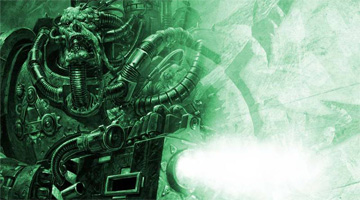 O Great Unclean One, Lord of Decay (Source: wikia.com) Game One - Played Khorne, Nurgle won by VP. He happily dominated mostly unmolested in the northeast (Estalia and Tilea), with the other Old Gods perhaps a little too preoccupied about not getting axed. Khorne's not so straightforward when the cards fall badly (most usually Slaanesh's Fields of Ecstasy preventing battle, and Tzeentch's Teleport to Chaos-forsaken corners of the map) and he doesn't draw his Blood Frenzy, and of course with bad luck at the dice, he's done for (though on the whole the dice were happy enough to turn up sixes) This outcome could partially be placed at Khorne's door, as he is traditionally the Nurgle-winnower. This was however down to perhaps Khorne's key vulnerability - mobility. He can, under normal circumstances, place at most three Bloodletters a turn, making each one that is neutralised a significant loss (one got teleported to Norsca early); as such, there is also a motivation to ideally site them where there aren't opposing Warriors (so no costly re-summoning is required), and it proved too much effort to march over the map. Did get the Cultist upgrade quickly enough, but between Temporal Stasis and Warp Shield making Tzeentch hard to pin down, and Slaaneshi Soporific Musk stealing them, double dial advancements began to get hard to come by. Was finally forced to bank on the other Old Gods delaying Nurgle on what would be the final turn, since Khorne going after Nurgle himself would basically hand it to Tzeentch. They didn't. 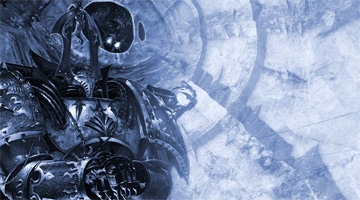 Changer of the Ways, Architect of Fate (Source: wikia.com) Game Two - Played Tzeentch, Tzeentch won by VP. Switched to the expansion Chaos and Upgrade cards, which provided for a fresh outlook. Having eight Cultists to play around with was a welcome change, especially when backed by Convocation to teleport up to three of them for just one power point. Finished on exactly 50 VP to take the game thanks to a bit of kingmaking by Khorne against Slaanesh (who had won Game One as Nurgle) Tzeentch's unique ability to replenish his hand to five cards strongly encourages magical play, and Havoc (Warriors and Daemons place corruption instead of rolling battle dice) was generally impregnable defence, while providing that coveted magic symbol for dial advancement. Warp Portal further messes with opponents by teleporting them out for zero power points, though at the cost of an extra card. Bolt of Change (Replace one Warrior with two Cultists of that player) was on the surface a superb anti-Khorne card, but it didn't work out that way due to Khorne summoning out all his Cultists quickly. The Blue Scribes, which moves up to two corruption tokens, had a small but critical role - now not only do Tzeentch's Cultists teleport at a whim to focus on a new region, his corruption follows too! On Khorne's side, his star performing card was probably Rampage, which forces an immediate battle (and yes, it counts towards his dial advancement). Then again, it's probably not as good as Blood Frenzy, which is free and doesn't even require a Bloodletter to be present - and of course, Khorne still has to actually draw them. 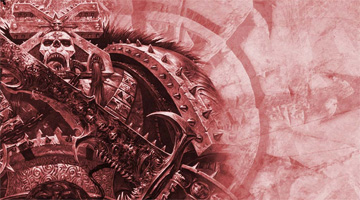 BLOOD FOR THE BLOOD GOD! (Source: wikia.com) Game Three - Played Slaanesh, Khorne won by dial. Nurgle and Tzeentch, for some reason, fought a long-running fruitless battle in the wastelands of Norsca. The initial token layout was good with the two Nobles next to each other in Kislev and Troll Country, and with a bit of fortune (and a couple of free rattlesnake cards that gave power points for each enemy summoning), Slaanesh started with a double-dial with Khorne misdirected by Tzeentch, concentrating his forces in The Badlands and Border Princes before Tzeentch teleported out. It wouldn't continue as well as the other Old Gods muscled in on Troll Country, and plans to shift out to The Empire were delayed by good Khorne dice. Action was heavily concentrated with the northeast not claimed by any faction until rather late (Tzeentch dropping a Glean), leaving Khorne to amass some corruption and VP in the southeast (not that he needed them) With the chosen Slaanesh upgrade making his Greater Daemon count as three Nobles, four hero tokens inexplicably finding their way to The Empire together with a lost Peasant, and two more Nobles from a dial advancement, The Empire was again looking ripe for Domination (10 VP a turn!). Added to that, Slaanesh had two of the one-power card Rapturous Excess that immediately gives one VP for each Noble, Hero or Peasant in a region (which is again 10 in this case) Unfortunately, this meant that the partyland was a huge target, and a gamble had to be taken on retaining enough defence to secure Domination, while not Ruining the VP farm outright. Sadly, Khorne killed exactly one Cultist with the doubled-defence card Pleasure Shield out, which meant the loss of all those tasty, tasty tokens and VPs as a result of premature Ruination. Khorne won the next turn with ease. 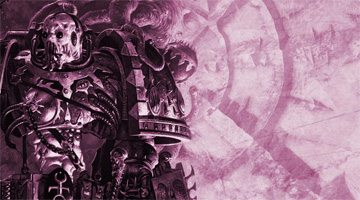 And no wins for the Prince of Pleasure and Pain today (Source: wikia.com) Party In Power (Revisited) All this, and the arrival of Mr. Card Game in a few months, has led me to recall my self-designed cardgame Party In Power (among others; MTG seems to have cottoned on to the "can't be sacrificed" design space, explored here, in recent releases). Since it's ripe for a redesign anyway (probably at least half the cards can be culled for a much more portable version, without losing much of the nuance or playability), I figured I might as well open-source all the information required to reproduce it - all the better if the concept gets "borrowed", I'll just create another one:
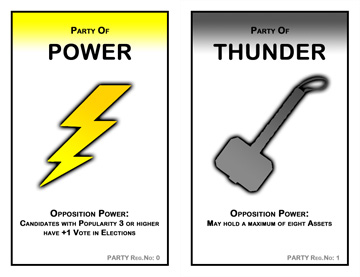 Head To Head Following are some basic strategy considerations: As an Opposition Party - Recall that the win condition is to get the most Victory Points, and as an Opposition Party, each Seat you secure is worth eight Victory Points (VP), as opposed to just one for the Party In Power (PIP). Since there are only 87 Seats in total, the PIP can gain a maximum of 87 VP. The practical upshot then is that winning two GRCs makes for almost certain Victory for an Opposition Party, with almost all GRCs providing for at least five Seats (i.e. two GRCs would commonly give 80 VPs or more, while denying at least 8 VPs to the PIP). To counter this, an Opposition Party winning a GRC is very difficult by design, though certain limitations:
So is it hopeless for the poor Opposition? Well, not quite...
 More potent than might be expected Having said all that, while two GRCs is an almost certain win, it is also very hard to win without a GRC (since that would require taking almost all the SMCs); the other common Opposition winning condition would then probably be one GRC and some combination of SMCs, NCMPs and loose VPs to push their VP total to somewhere above 65, and depending on the PIP to lose a total of about 20-odd Seats (probably from two or three GRCs, add some SMCs) Which brings us to perhaps the greatest strength (or weakness, if not exploited) of the collective Opposition - they can work together. The game assumes active verbal deal-brokering (well, it could be done without, but that makes things much harder for the Opposition), but not outright revealing of actual Asset cards. The key observation is that while no single Opposition Party has the Assets to contest all Elections, or even most of them, it is basically near-certain that all Elections can be contested by some Opposition Party, with some degree of cooperation. By the way, conceding a total walkover - having no Opposition entry in an Election - is a massive boon to the PIP, who then can avoid deploying any Ministers or Action cards, and can furthermore be rid of his worst Candidates at no risk; a few walkovers can yield an unreasonably strong Talent Pool, with no Opposition getting any Seats (or NCMPs) in the meantime. In short, the Opposition might not win even if they cooperate (especially at the start), but they are likely doomed if they don't and start throwing around cards like Political Infighting. Seen in this light, Party In Power is a game of negotiation (e.g. "I will field my good five-man team in this Election for Ang Mo Kio GRC, together with a powerful Reaction card, and in return I will not contest the next two GRCs unless asked to") and bluffing (e.g. the proposer then submits six junk Asset cards in the Polling Day phase, possibly drawing out a Minister from the PIP). Which is basically politics in a nutshell. The biggest shift in strategy within a game probably comes when an Opposition Party actually claims a GRC. Now, not only is the PIP on their toes with that party (since allowing them another GRC spells defeat), other Opposition Parties will also have to think very carefully about how much they trust them, especially whenever a GRC Election comes up. As the Party In Power (PIP) - Your strengths are obvious and public: strong Candidates, Ministers to step in when needed, and Action cards on top of all that. General counter-strategy is quickly covered as it is just the opposite of what the Opposition wants. Try to divide and conquer the Opposition (though it probably won't work outright if they are experienced players) and prevent them from taking any GRCs (since it's hard to lose without conceding any), and if that fails, make very sure not to lose two GRCs to the same party. The other main danger arises from Opposition Parties that have been quiet for too long while refining a full hand of Asset cards. Though their non-participation is generally good for you, they may well be building up a killer hand (e.g. suited Candidates in preparation for a huge doubled Cover All Bases explosion), which can be particularly dangerous if you happen to be short on Ministers. In this case, look out for Action cards that can force him to reveal or discard Assets. Wonder what it would take for a card game to get published, hmm. Next: Friday Night
|
|||||||
 Copyright © 2006-2025 GLYS. All Rights Reserved. |
|||||||